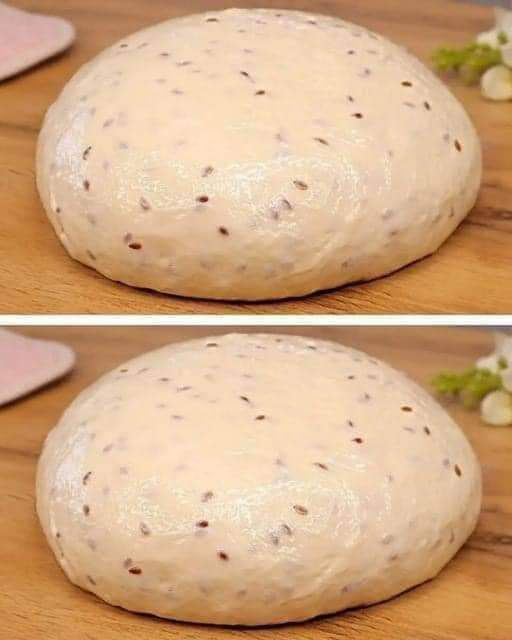ADVERTISEMENT
1. **Activate the Yeast**
In a small bowl, combine the **warm water**, **sugar**, and **yeast**. Stir gently and let it sit for about 5-10 minutes until the mixture becomes frothy. This step is essential for making sure your yeast is active and ready to help the dough rise.
2. **Mix the Dry Ingredients**
In a large mixing bowl, combine the **flour**, **salt**, and the three types of **seeds**: sunflower seeds, sesame seeds, and flaxseeds. Stir them together to distribute the seeds evenly through the flour.
3. **Combine Wet and Dry Ingredients**
Once the yeast mixture is frothy, add it to the bowl of dry ingredients along with the **olive oil** and **honey** (if using). Mix with a spoon or your hands until a rough dough forms. If the dough feels too dry, add a little more water, one tablespoon at a time. If it’s too wet, sprinkle in a little more flour. You’re aiming for a dough that’s soft, but not sticky.
4. **Knead the Dough**
Turn the dough out onto a lightly floured surface and begin kneading. Knead for about **8-10 minutes**, adding a little flour as needed, until the dough becomes smooth, elastic, and slightly tacky to the touch. You can also use a stand mixer with a dough hook attachment for this step.
5. **First Rise**
Place the kneaded dough in a lightly oiled bowl and cover it with a damp cloth or plastic wrap. Let it rise at room temperature for about **1-2 hours**, or until it has doubled in size.
6. **Shape the Dough**
After the dough has risen, punch it down gently to release the air bubbles. Turn it out onto a floured surface and shape it into a round or oval loaf, depending on your preference. You can also shape it into a **boule** (round) or **batard** (oval) style, both of which are traditional artisan shapes.
7. **Second Rise**
Place your shaped dough onto a piece of parchment paper and cover it again with a cloth. Let it rise for another **1 hour** at room temperature, or until it has puffed up significantly. You can also refrigerate it overnight for a longer, slower fermentation to develop deeper flavors.
8. **Preheat the Oven**
While the dough is in its second rise, preheat your oven to **450°F (230°C)**. If you’re using a **Dutch oven**, place it inside the oven to preheat as well. A hot oven and the moisture trapped in the Dutch oven will help your bread develop a crispy, golden crust.
9. **Slash the Dough**
Once the dough is ready to bake, use a sharp knife or a razor blade to make a few shallow slashes on the top of the dough. This will help the bread expand evenly while baking.
10. **Bake the Bread**
If you’re using a **Dutch oven**, carefully place the dough (with parchment paper) into the preheated pot and cover it with the lid. If you’re not using a Dutch oven, place the bread directly on a baking stone or baking sheet. Bake for **30 minutes** covered, then remove the lid (if using a Dutch oven) and bake for another **15-20 minutes** until the bread is golden brown and sounds hollow when tapped on the bottom.
11. **Cool and Slice**
Once baked, remove the bread from the oven and let it cool completely on a wire rack. This is important because it allows the interior to set properly. Once cooled, slice and enjoy!
### Tips for Perfect Seeded Artisan Bread
– **Add Extra Seeds**: Feel free to get creative with the types of seeds you add to the dough. A combination of **pumpkin seeds**, **chia seeds**, or even a mix of **herbs** like rosemary can add unique flavors.
– **Use a Dutch Oven**: If you want that signature **crusty artisan look** with a soft, airy interior, a Dutch oven is your best friend. It traps steam and creates the perfect baking environment, ensuring your bread has a crispy crust and chewy crumb.
– **Control Humidity**: To get an even better crust, place a small tray of water on the lower rack of the oven to create steam while baking. This will help keep the crust from becoming too thick and hard, creating that perfect balance of texture.
– **Cool Before Cutting**: While it’s tempting to slice into your freshly baked bread, give it at least **30 minutes** to cool. Cutting too soon can result in a gummy texture because the steam is still escaping from the bread.
### Conclusion: Why This Seeded Artisan Bread Is Worth the Effort
Making your own artisan bread might seem like a daunting task, but this **Seeded Artisan Bread Dough Recipe** simplifies the process without sacrificing flavor or texture. The combination of seeds adds both nutrition and a delightful crunch, while the slow fermentation and high-heat baking create the ideal structure and flavor.
This bread is perfect for everything from sandwiches to dipping into soups or simply enjoying with a little butter. With its rustic appearance and rich, hearty flavor, this seeded artisan bread is a true crowd-pleaser that’ll make you feel like a baker in a European café. So, roll up your sleeves, get your hands into that dough, and enjoy the delicious, satisfying process of making your very own **artisan bread**!
ADVERTISEMENT
